During a spectacular fondue dinner at the Auberge du Château Bromont last February, people at my table were discussing how our visit to Québec’s Eastern Townships felt both familiar and completely different from what we’d normally experience during a ski trip in the northeast. Someone mentioned that it was similar to John Travolta’s classic line from the film “Pulp Fiction” — they’ve got the same stuff that we have back home, but here, it’s just a little bit different.
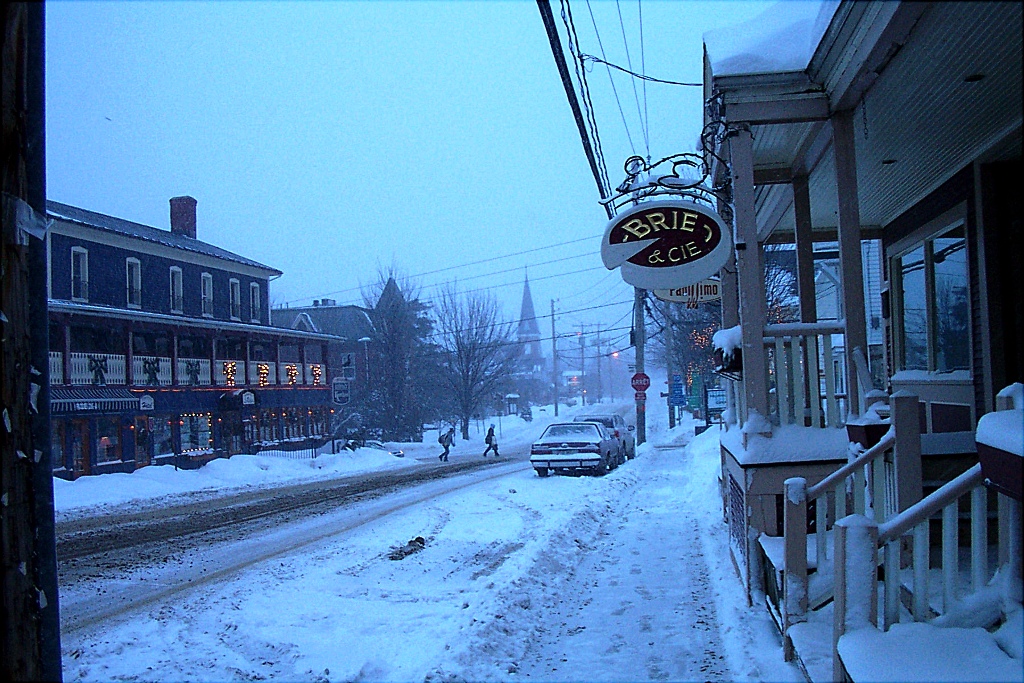
Growing up in Central New York, I identified with this remark, having noticed the similarities between the Finger Lakes and the Eastern Townships: rolling hills, gorgeous lakes, lots of agritourism, and quaint Victorian-era villages. But calling the Townships a French-language version of the Finger Lakes overlooks the very things that make this region so attractive, especially to people from south of the border.
Most obvious is an unlikely fusion of cultures that can be traced back to 1792, when the area was declared open to settlement, leading to a multi-decade land grab by British loyalists, New England farmers, and eventually immigrants from Ireland and Scotland. This Anglo invasion explains why many of the place names (such as Hatley, Waterloo, East Hereford, Dunham, Wickham, Farnham, Granby) sound like something out of a Dickens book. A final wave of migration started in the mid-1800s, when French Canadians streamed into the Townships and became the predominant population by the end of the century.
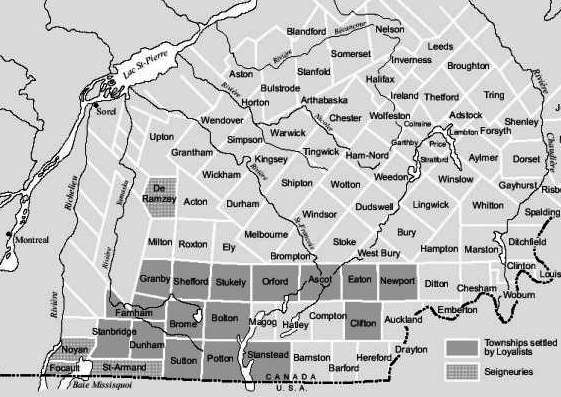
For visitors, the end result of this unique history is what has been described as an “absurdly picturesque” region that combines several of the most positive aspects of France and New England. You’ll find: a) classic New England architecture everywhere you look (covered bridges, round barns, quaint white churches with tall spires, well maintained houses built with clapboard, brick, and stone), b) regional and French gastronomy that’ll make your head spin (incredible cheeses, artisan breads, mouth-watering pastries, immense wine cellars), combined with c) extremely welcoming, down-to-earth locals, most of whom speak very good to nearly flawless English, taking away the language-barrier issue for monolingual tourists.

So if you live in the northeast and are considering a ski trip that’s truly different from any other in North America — a region that manages to be both pastoral and sophisticated — you have no excuse. With expensive, delay-laden flights, complicated transfers from airports, and jet lag taken off the table, all you need to do is pack up the car and head north.
While none of the Townships’ four mountains qualify on their own as a ski destination (vertical drops range from 1,300 to 1,772 feet), they’re a classic example of the sum being greater than the parts, or to use a food metaphor, a well-designed “tasting menu.” Since each has a clearly delineated specialty, you can spend anywhere from half a day to two days exploring each mountain, according to your preference. Finally, none is more than a 30-minute drive from the next, making the Townships perfect for a multi-area visit.
Ski Day 1 (Morning): Sutton
Summarizing a ski area’s market differentiator in one word is usually a difficult task, but anyone who’s been to Sutton can do it without breaking a sweat: glades. With more than 40% of the terrain consisting of skiable trees, that’s what has set this mountain apart for the past 50 years — ever since Réal Boulanger (son of Sutton founder Harold) decided to abstain from “fixing” the terrain through typical ski industry practices (re-grading fall lines, moving boulders, clear cutting most of the trees). Instead, he pioneered the art of creating, managing, and marketing designated glades, an idea that turned out to be several decades ahead of its time.
Although Sutton’s 1,500 vertical-foot claim is somewhat misleading (unless you traverse diagonally from skier’s right to left, most runs are in the 1,000-foot neighborhood), no halfway informed skier goes there with the intention of racking up big vertical numbers on high-speed groomers, even though there are plenty of those.
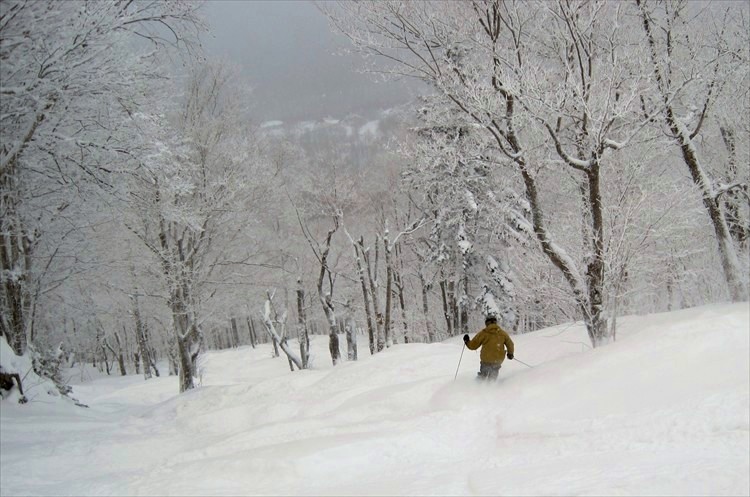
No, the real reason to ski Sutton is to move from point to point through the stands of maple and birch trees, skipping back and forth through a spider’s web of trails and glades, with no particular destination in mind. Go there on a powder day and you’ll see what I mean — there’s something almost otherworldly about the way Sutton’s artfully arranged woods shots are laid out. While the tree-skiing isn’t as steep as at Stowe, Jay Peak, Smugglers Notch, or Mad River Glen, Sutton’s glades win in my pet category: aesthetics.
Coincidentally, our group had the added luck to get an all-morning tour of the mountain from the guy in charge of Sutton’s aesthetics, Operations Director Luc Boulanger, who knows every sapling, rock, and lift tower on a first-name basis. As we rode uphill on an eclectic collection of chairs, some of which dated back to the mid-1960s, Luc discussed the many ways that his team manages Sutton’s most vital resource: trees. We were astounded to learn how much thought and work goes into creating and maintaining a forest that looks natural and also provides great glade skiing. His biggest concern is keeping skiers and boarders from riding over new growth, which prevents re-generation, resulting in a vicious circle of open spaces, erosion, wind damage, and eventually dead trees.
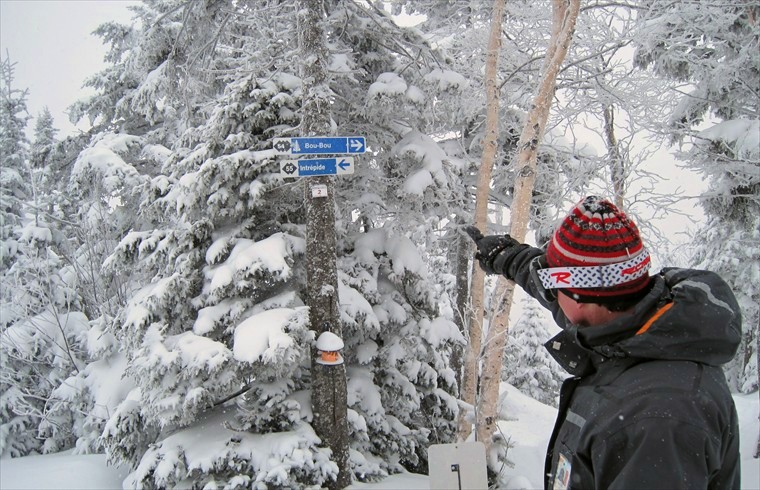
And while Sutton gets up to a third less snow per year than nearby powder king Jay Peak (hard to believe considering how close they are to one another as the crow flies), it also gets significantly less wind. So during big, gusty storms, the lifts at Sutton will be spinning smoothly while Jay is often on windhold, as was the case that day.
Ski Day 1 (Afternoon): Bromont
Instead of calling it a day after our powder fest at Sutton, we pressed on and drove 25 minutes to that ski area’s polar opposite: Bromont. Whereas Sutton radiates a comfy, old-school retro chic, Bromont’s ambiance is modern, colorful, and *really* busy, like a crowded IKEA store. With a whopping 850 snowguns covering seemingly every corner of its seven trail pods, think of Bromont as the Eastern Townships’ Hunter to Sutton’s Belleayre.
Under the direction of Charles Désourdy since 1997, Bromont has mushroomed from a tiny local’s area to more than 450 acres of rolling trails and glades across seven terrain pods, as well as the largest night skiing operation on the continent. Literally every season, management cuts new trails, installs new lifts, and builds more structures. The ability of the resort to figure out what its customers want and then provide it in a timely fashion is truly impressive. Bromont’s most recent on-mountain news is the purchase of two chairs from a pair of Québec mountains that have closed over the past year or so (Gray Rocks and Mont Joye), along with a brand new 10,000-square-foot day lodge in the Versant du Lac sector.
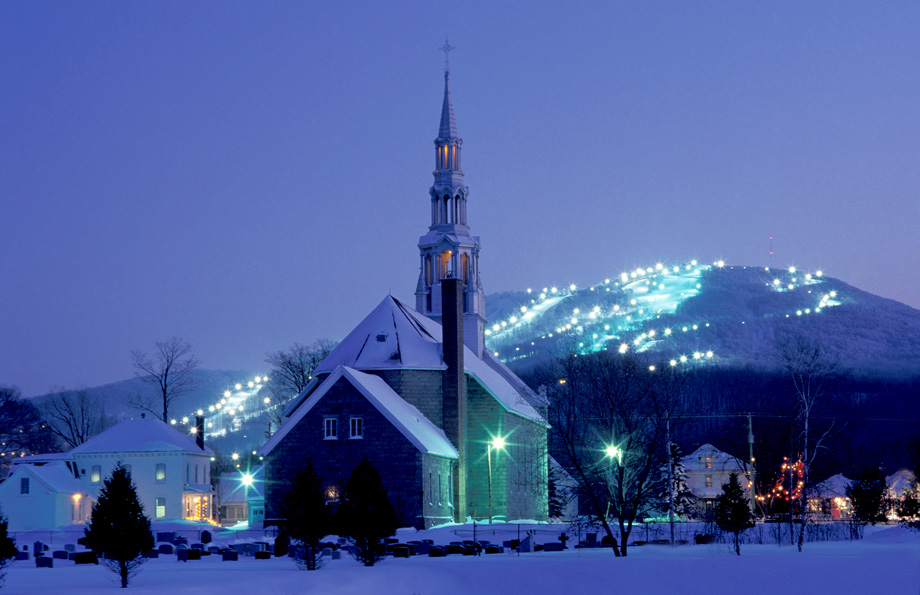
By providing a wide selection of meticulously groomed intermediate trails, an array of dirt cheap season passes, and a sprawling surrounding village, Bromont has become wildly popular with families and teens from the Montreal region. Upon seeing the huge number of cars in the parking lot and the bustling base area on a weekday afternoon, one member of my group joked that “Bromont must be French for gold mine.”
Even if you prefer your ski areas more on the rustic side, I can personally recommend one of the resort’s most beloved promotions: its “Nuits Blanches” (“Sleepless Nights”) Saturdays, held six times a season, during which Bromont stays open until 2 am.
A few years ago, my wife and I attended one of these all-night free-for-alls, and had a great time. Even though both of us were dead tired when we arrived at 11 pm, the energy of the late-night crowd was contagious, and we skied without a break until closing time. And while Bromont’s vertical drop is only 1,300 feet, it’s nice and consistent: no flats. I still remember turning to her on the lift and asking “where else can you do lift-served laps in the trees at one in the morning?”
Ski Day 2: Owl’s Head
Following a stormy Monday at Sutton and Bromont, our next stop was a gorgeous sunny day at Owl’s Head, complete with stunning views of Lake Memphrémagog, Jay Peak, and Mont Orford. Dropping 1,772 feet almost to lake level, Owl’s Head is a fun, unpretentious mountain that, with the exception of three high-speed lifts, feels like a trip back to the mid-1980s. While most of the terrain is perfect for those who like consistently-pitched blue groomers, there are also several short, steep pitches along with a handful of fun glades.

Similar to Sutton, Owl’s Head has been owned by the same family, the Kormans, since it opened in 1965. Of the four Eastern Townships ski areas, it has the most Anglophone influence, with equal amounts of English and French overheard on the lifts and in the lodge.
Owl’s Head has always been positioned as a low-cost, no-frills, family friendly hill, and the day we were there — one of two midweek days (Tuesdays and Wednesdays) when tickets are only $15 — there were plenty of locals on vintage equipment, out enjoying the sunshine and beautiful snow. The nine inches of new powder that fell the previous day made for near perfect conditions. The people we met on the lift rides were all very proud of their hometown hill, although one person grumbled that the terrain was more challenging a couple decades earlier, before several of his favorite lines were graded to make it more intermediate friendly.
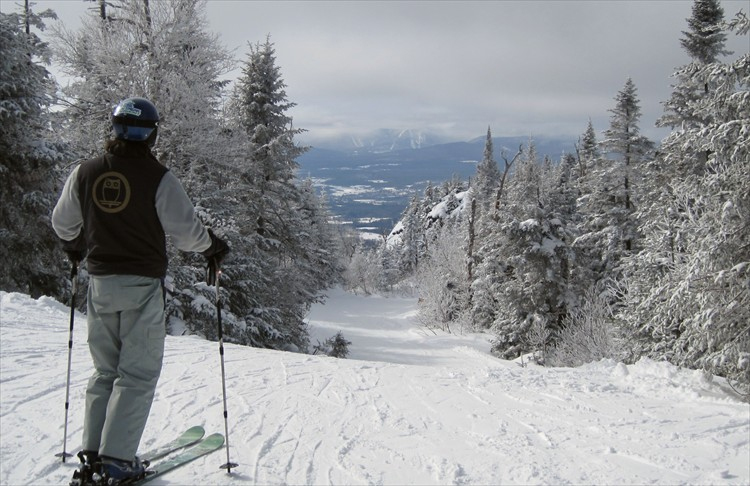
Rising from the shores of Lake Memphrémagog and visible from many points throughout the Townships, Owl’s Head was, according to local folklore, not named after any similarity to the easily recognized bird. Instead, its outline was believed to resemble the profile of a beloved Native American tribal chief (named “Owl”) as he lied in repose after his death.
Given Owl’s Head’s low profile outside of Quebec, everyone was pleasantly surprised by the mountain’s breathtaking views, entertaining terrain, and unaffected vibe, all surrounded by, what else, more friendly people.
Ski Day 3: Mont Orford
So you go to Sutton to ski the trees after a dump of snow, to Bromont for well manicured groomers when it hasn’t snowed recently, and to Owl’s Head for the views and high-speed cruising. Where does that leave Mont Orford, the Townships’ oldest operating mountain? Most say that it has the region’s best overall terrain, and I’d agree.

With the exact same vertical drop as Owl’s Head, 1,772 feet, Orford feels like a “best-of the east” contained in one medium-sized ski area. You’ll find everything from long, consistently-pitched groomers, a nice selection of single- and double-black off-piste shots, to an array of challenging glades and one separate peak with nothing but easy blue and green trails and trees for lower-level skiers. Like a shorter version of Whiteface, Orford has three separate peaks, along with a susceptibility to strong winds, but if you time your visit to correctly (as we did: a quiet weekday, 36 hours after a storm), you’ll have an exhilarating day. And with stunning views of 27-mile-long Lake Memphrémagog, Owl’s Head, and Jay Peak to provide visual interest, it’s an excellent all-around mountain.
We spent the day trying to keep up with Olympic medalist and World Cup champion aerialist Lloyd Langlois, who claimed to be an undistinguished bump skier (completely false). By the end of the day, everyone in our group was impressed by the wide variety of terrain at Orford, and all that soft, barely tracked snow just a few yards off the groomed trails.
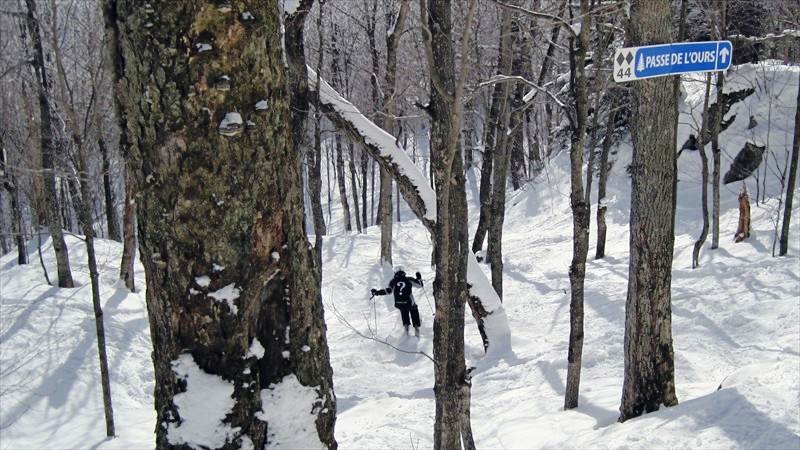
For destination visitors, Mont Orford comes off as a smooth-running operation: a nice base of snow, great grooming, all lifts operating, and a busy if undistinguished base area. Positioned directly off a major highway only 70 miles from Montreal, and just a few minutes from Magog, a charming lakeside town, it would seem to have all the elements for success. However, in another parallel to Whiteface, it’s located in the middle of a publicly-owned park with a big “no development” clause. When the provincial government tried to sell 1,150 acres of public land at the base of Mont Orford to a private developer with visions of creating a large real estate component, a massive protest was launched.
After several years of contentious wrangling, the issue was recently settled, and the Quebec government is now trying to lease the operation of the ski area and golf course to a private operator. Despite its controversial recent past and persistent rumors about its future — a saga that undoubtedly sounds familiar to New York State residents — Orford is a fun time and worth exploring for a couple days.
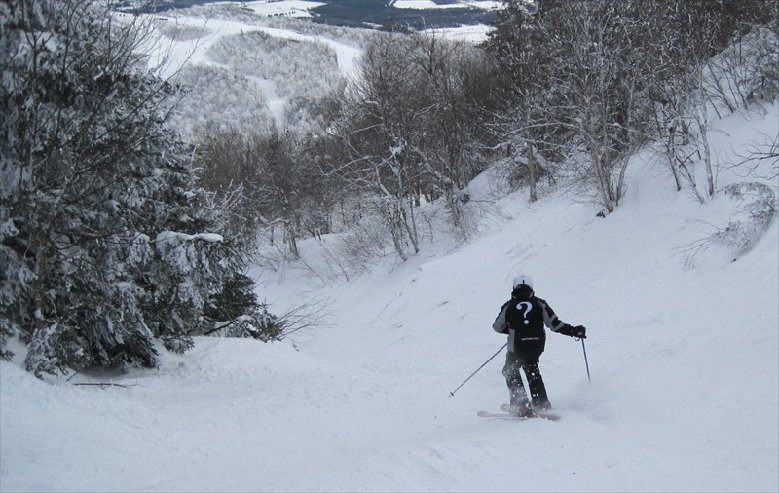
Off-Mountain
While this trip was built around downhill skiing, there are piles of other things to keep you busy during the winter, including dogsledding, skating on a 1.5-mile-long ice path along Lake Memphémagog, snowmobiling, cross-country skiing or snowshoeing on 600 miles of trails, ice fishing, luxuriating at high-end spas, visiting a Benedictine abbey, year-round wine tastings, and touring historic sites. You’ll run out of vacation days before you run out of things to do.
For trip-planning assistance, the people at the non-profit Tourism Eastern Townships were very helpful:
Eastern Townships Official Tourism Website
Travel writers have been raving about the gastronomic offerings found throughout the region for years (do a search on “Eastern Townships” and “food” or “cuisine” to find dozens of articles), and I can confirm that it’s all true.
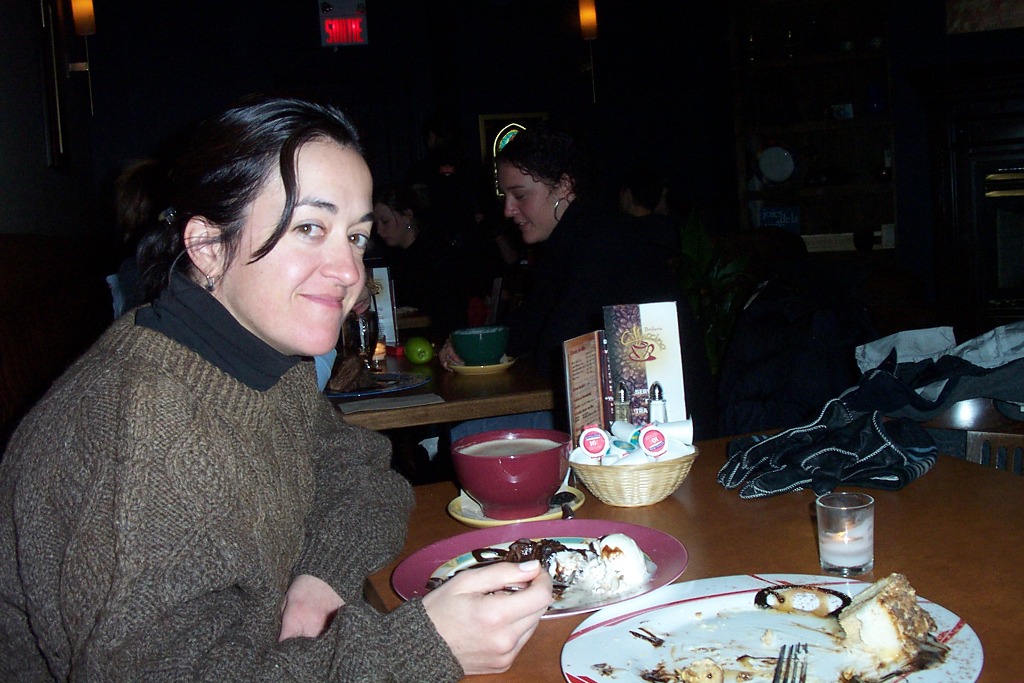

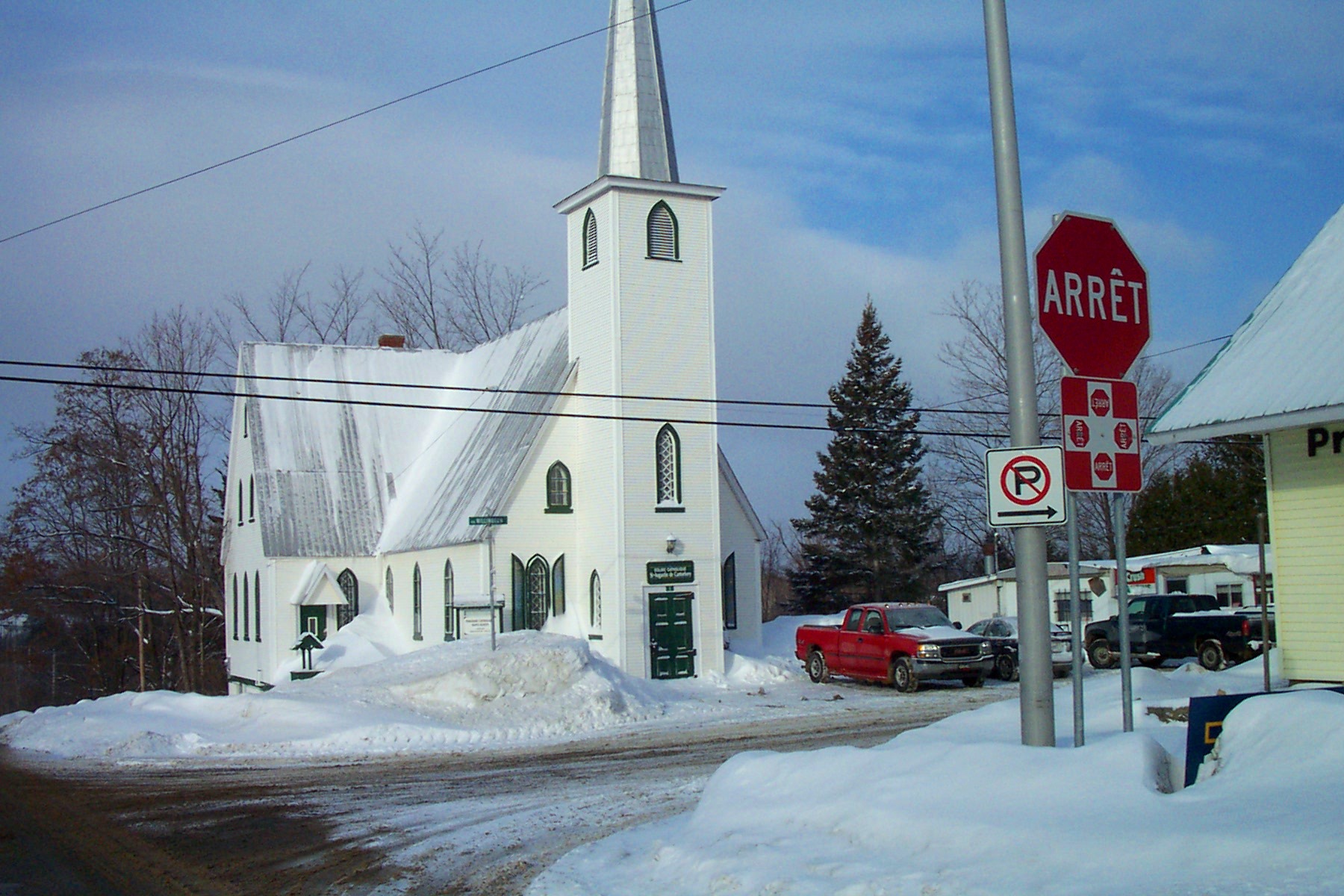
James … It’s not hard to see why you are so attracted to the region. While I’m probably more of a Burlington Vermont kinda guy, if you lived in Montreal you could really have it all. Beautiful city with old world charm, Tremblant, The Townships, Jay Peak, Stowe and Smuggs. The key for Zelda and I would be to figure out how to get a full week off, sans le petit jeune fille. Maybe when she’s older it could work.
Do you have plans to go back this season?
Enjoyed the article! I’ve been to Owl’s Head and found it to be an amazing bargain for 3 high speed quads and only $15 for their Tue/Wed rates. There’s also Mont Joye in North Hatley and Mont Bellevue in Sherbrooke to round things out in the Townships. Mont Joye is 500′ vertical and has a fixed grip quad and T-bar, fun trails and good poutine. Mont Bellevue is a city area with Pomalifts. Jeremy
Thanks, Jeremy. Hate to break the news to you, but Mont Joye is no longer. They pulled out the lifts several weeks ago (article), joining Mont Shefford and Mont Glen, which went NELSAP a few years ago.
Thanks so much for this excellent content on the Eastern Townships! I enjoyed the article and am looking forward to your future piece of Le Massif.
The Townships were on my “to do” list last year but I never got my passport. This year, they are now on my “must do” list. Sutton and Orford for sure, maybe Owl’s Head just for something different and the views. Probably will skip Bromont. All are about a 2.5 hour drive each way, but I might look into lodging and make it a long weekend. Can you recommend any dirt cheap lodging? A quick search online did not yield any hostels in the area.
Thanks, Steve. At the end of the article, I added a link to a listing of B&Bs in the region, and there are a lot of them ranging in price from budget to posh. Over the years, the wife and I have stayed in a handful of different ones and always had a great experience. Especially good if you’d like to meet people from the area, which is an important part of a visit to the Townships.
I can’t provide any hostel recommendations as I’ve never stayed in one there.